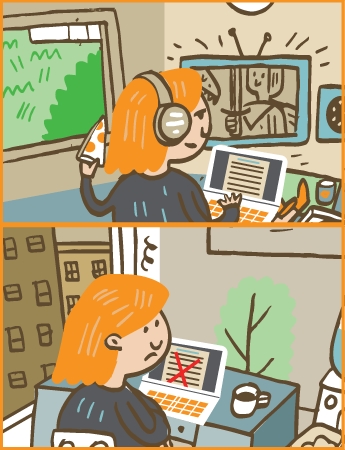Writers often wonder why their work was rejected. The answer is almost always obvious. After receiving more than 20,000 fiction submissions over the course of 8 years, I’ve seen every mistake a writer can make. I’ve also made most of them myself.
Editors complain about writers not following guidelines, probably because it’s such an easy and obvious thing to complain about. How hard is it to double space your story or save the file in a certain format? It shouldn’t take more than two or three minutes to get your manuscript laid out properly. If it takes longer, you should rethink how you format your manuscripts. Still, as often as editors complain about writers who disregard their guidelines, only a small fraction of submitters make this mistake.

‘You don’t have to send every piece out right away.’ Illustration by Josh Quick.
A more common mistake writers make is submitting without ever reading the publication. An editor can usually tell within the first page if the submitter has actually read some of the magazine’s stories. Quite a few submissions make editors say, “Wow, we definitely would never publish anything like this, and if the writer had taken ten seconds to read anything we publish, he or she would’ve known that.” It’s almost impossible to get an acceptance without knowing what the magazine publishes, but many submitters skip the content and head straight to the guidelines anyway. As common as this behavior is, it’s not the biggest mistake writers make when sending out their work.
Remember those 20,000 submissions I talked about before? Well, the vast majority of them were rejected because they weren’t ready to be submitted. They arrived in an unpublishable state. Certainly some of them could have been salvaged with a little proofreading. Others needed significant editorial work to become publishable. And a decent chunk of them were simply throwaway stories. Regardless of the specific issue, the overarching theme among these pieces was that they never should have been submitted in the first place.
That’s not to say they weren’t worth the author’s time or effort, but they certainly weren’t worth the effort of submitting to a lit mag. Submitting is an exhausting process. The time wasted looking for a venue and following the venue’s guidelines could have been better spent making the submission ready for publication.
This doesn’t apply to all rejected stories. Not even close. Many of the stories we rejected were publishable–just not by us. Remember, a lot of this is a matter of taste.
But the fact that many submissions aren’t ready to be submitted isn’t a matter of taste. It’s a matter of fact. Writers are often in too much of a hurry to get their work out there. They can’t be bothered to make it as good as it could be. Blame it on social media or the need for instant gratification. Whatever the reason, many writers think putting the final punctuation mark in place means it’s time to submit.
You don’t have to send every piece out right away. There’s almost never the need for a short story to be published instantly. It’s not breaking news. Sure, your story might have some timely elements based on current events, but good fiction is timeless. It doesn’t have to be published today to be relevant.
Aside from being a waste of time, this practice can also be detrimental to a writer. If one of those hasty submissions is actually published, your name is forever associated with a bad story.
It’s happened to me. Many times. I’ve submitted some really bad stories. And sometimes they were published. Looking back on it, I’m embarrassed by some of my published work, and I wonder how it has negatively impacted my writing career.
If you want a fighting chance at having your work published (while not looking like an amateur in the process), you need to make sure your story is 100% ready to be submitted. Not 99%. Given the fierce competition that exists in publishing today, you don’t have room for error.
So how do you know if a story is ready? Here are some signs you shouldn’t submit:
- You haven’t read it over at least five times
- You wrote it less than a week ago
- You aren’t proud of it
- You are contemplating sending it to an inferior lit mag because you are pretty sure they’ll publish anything
- It started as a writing exercise and never really moved beyond that stage
- It’s been rejected a dozen times or more with no positive feedback
- You shared it with another writer and that writer didn’t enthusiastically tell you to send it out
- It still has typos in it
Every bad submission you send out makes you less likely to ever be published by a specific venue. It’s your way of telling editors you don’t really care.
Only submit your best work. There’s no shame in having a hard drive full of stories that just didn’t work out. They don’t need to be submitted. And you don’t need to fill some arbitrary submission quota.
Even the best writers in the world have written their fair share of crap, but they don’t submit it. So you better hold onto yours. After all, you are what you submit.
Note: The opinions expressed by guest bloggers at the Submittable blog are theirs alone and do not necessarily reflect the opinions of Submittable.
 Nathaniel Tower is a former English teacher who now spends his days as a content writer and brand strategist at a web design company. When not at work, he writes fiction and goes for long runs while juggling. He served as the managing editor of Bartleby Snopes literary magazine for eight years before closing the publication to focus on other literary pursuits. He is the author of Nagging Wives, Foolish Husbands, a collection of surreal tales about married life published by Martian Lit in 2014. Visit him at https://nathanieltower.com/.
Nathaniel Tower is a former English teacher who now spends his days as a content writer and brand strategist at a web design company. When not at work, he writes fiction and goes for long runs while juggling. He served as the managing editor of Bartleby Snopes literary magazine for eight years before closing the publication to focus on other literary pursuits. He is the author of Nagging Wives, Foolish Husbands, a collection of surreal tales about married life published by Martian Lit in 2014. Visit him at https://nathanieltower.com/.